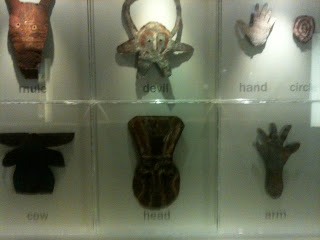Back in August I went to the S.A Museum Aboriginal Cultures Gallery. There is displayed items from the worlds largest collection of Australian Aboriginal Culture artefacts.
The exhibition was amazing although it does feel a little sad, there is all this culture in the rooms and I know it is diminishing in the real world. It is sort of like a funeral in away to me, this is what was.
I really liked this piece of carving on the shield. The Aboriginal Cultures of south eastern Australia produced masterpieces in wooden carvings.
These are shields the men used to ward off thrown weapons like spears and boomerangs. They are heavily decorated. They seem so skinny to be shields but I guess it would be easier to carry around than a huge one. The first shield on the left is from northern western Victoria in the 1800s. The next inline is from the juction of the Darling and Murray River in NSW 1800s. Next is from Dimboola in western Victoia. The last on the right is from the lower Murray in South Australia 1800s.
These are spear thowers made in the 1800s, I like the soft patterns on them. The top is from the Lower Murray, second Lake Alexandria and third is from NSW.
These are my favourite in the whole exhibition, the are the Tindale Masks. They were worn by young Aboriginal men in a series of performances during 1947, proceeding their initiation. It was a month long ceremony at Twelve Mile Camp near Port Hedland in Western Australia. The performances were organised by the Nyangumarda and Palyku people. The names underneath the masks were given by the museum. It was six years after the ceremonies that Norman Tindale noticed the abandoned masks near the old dancing ground. I think these are my favourite because I am a performer my self and i really appreciate what goes in to it. Not only that but something about these masks draw me in, they have a darkness about them.

Clothes back in the day were mostly to show a persons status, whether they were married, widowed or initiated. In ritual occasions the body could be decorated, with accessories. The photo above is of a head ornament, it was worn by members of visiting Arrernte groups to signal their friendly intentions.
These are nose pegs worn by initiated Arrernte men as a status symbol.
The Yuendumu School Doors
In 1983 senior Warlpiri men took an opportunity to paint their scared Dreaming designs on the doors of a remote Yuendumu school, 250km north west of Alice Springs. It is now an important moment for Australian Art, it symbolised the Warlpiris decision to explain the Tjukurrpa to the world. There was 30 original doors. They reveal ancient stories and beliefs, they are marvellous to look at, there are makings from the school children and damage from the years of use. It all adds to the history of the doors.





























